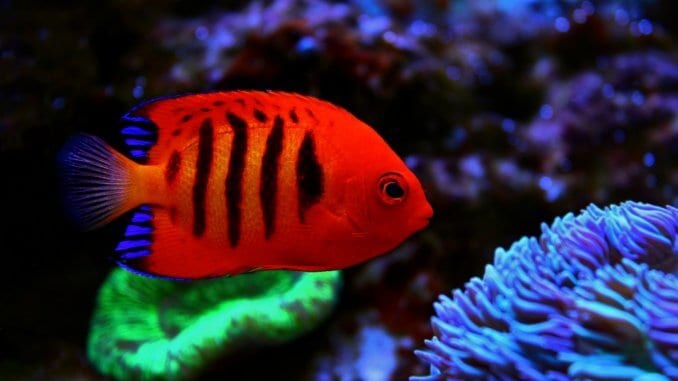
Just over 70% of the Earth’s surface is covered in water, with 96.5% of it being held in the ocean. It goes without saying then, that there are bound to be thousands of species of fish and other creatures living in the sea.
Fish come in all different shapes, sizes, and colors; there is so much diversity within the sea.
All of these fish are unique in their own way; from the mesmerizing Mandarinfish to the almost cartoon-looking Picasso Triggerfish.
We’ve narrowed down over 20,000 species of fish, to just the 15 most beautiful fish in the world.
15. Threadfin Butterflyfish
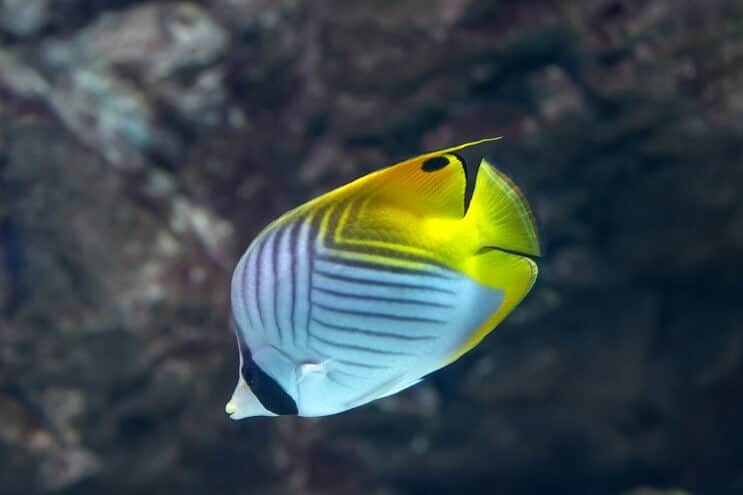
This Butterflyfish is the centerpiece in many home aquariums; it has a beautifully bold personality to match its bold colors.
It reaches lengths of 9 inches and has a calm demeanor which is why it is one of the most photographed underwater fish.
Their body is pearly white and this blends into a bright yellow color towards the tail end, and up to the dorsal fins. It also has diagonal black perpendicular lines which create a chevron like pattern.
These fish require large tanks (a minimum of 100 gallons) and adapt well to aquarium life, making it a beautiful fish for beginners.
14. Betta Fish
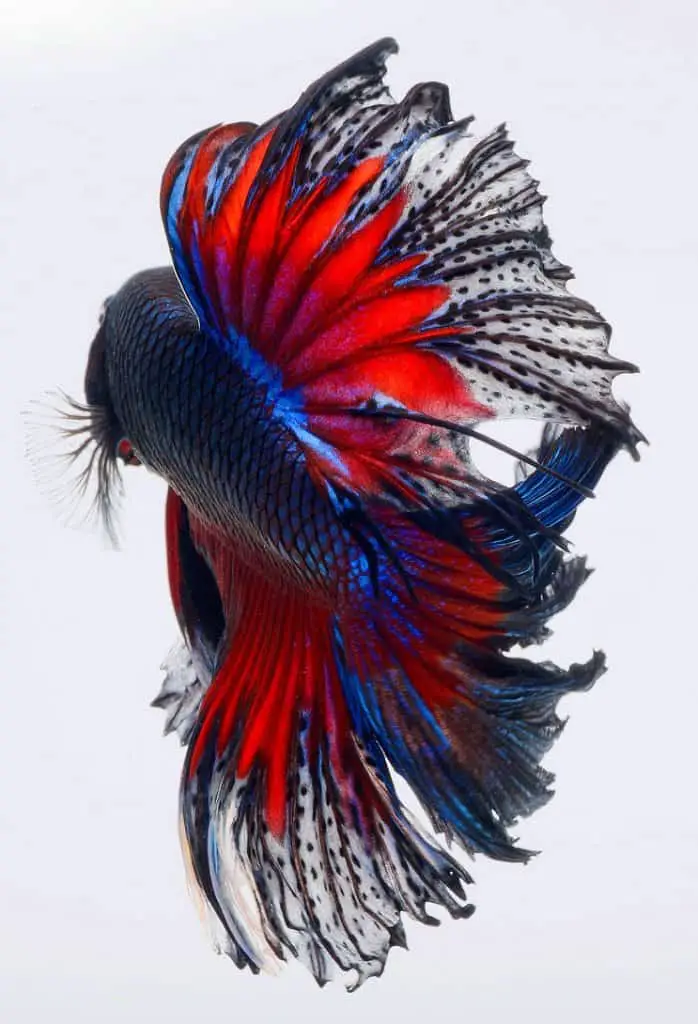
Betta fish, also known as Siamese fighting fish, are one of the most popular aquarium fish.
They have been selectively bred to have bright colors and unique tails; and due to their aggressive nature, they were also bred to fight.
In the wild, Bettas don’t display the same beautiful colors that we have achieved through selective breeding in aquariums. They are a lot more dull, to blend in with their natural habitat – rice paddies and floodplains.
Bettas are labyrinth fish meaning they can breathe oxygen directly from the air, as well as taking in oxygen through their gills.
As we’ve already mentioned, Bettas are quite aggressive and only one male should be kept per tank. They are usually kept in species only tanks.
13. Regal Angelfish
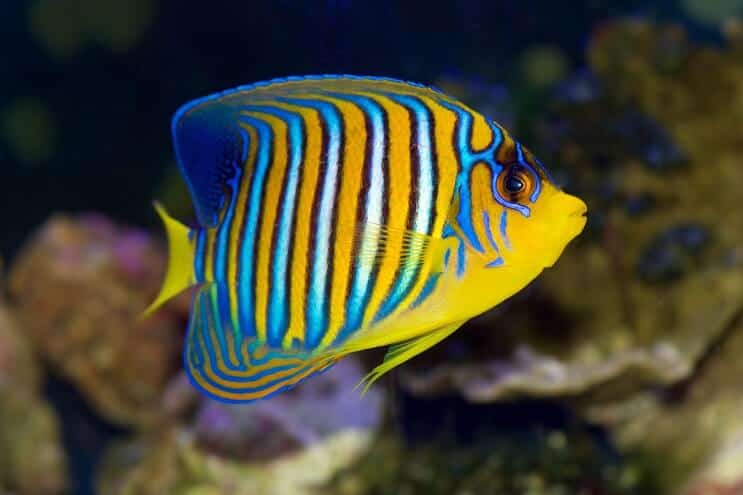
All Angelfish have a beautiful elegant look to them, but the regal angelfish is one of the most beautiful. It is also one of the most difficult to keep in an aquarium.
They grow to around 10 inches in length, which means they require a huge tank (a minimum of 100 gallons with plenty of hiding spots).
In the wild they prefer areas that are naturally rich in coral reefs, and they stay close to areas with plenty of cracks, caves, and crevices. They typically live singly or in mated pairs.
If you’re thinking of buying a Regal Angelfish, always buy specimens that have been caught in the Red Sea or the Indian Ocean. Unfortunately, many of these fish which are caught in the indo-pacific have been caught using chemicals and don’t survive long.
They should always be quarantined for a few weeks before adding them to your main tank. They can find it difficult to adapt to life in captivity, smaller juveniles usually adapt better.
12. Symphysodon Discus
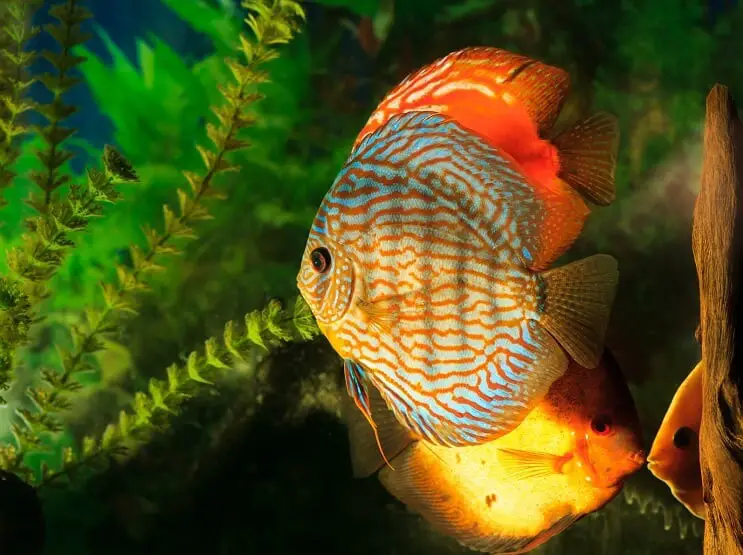
This beautiful fish is often thought of as the king of the aquarium, it’s a stunning centerpiece and it’s not hard to see why.
From the front it looks very thin, but from the side they are a round disc shape. They usually reach around 6 inches in length and are very peaceful, elegant and graceful.
Also known as the Heckel Discus and the Pineapple Fish, Discus come in lots of different colors, but the red coloring is considered to be one of the most beautiful.
They are found in various areas of the Amazon River, and they are one of the most difficult species of freshwater fish to keep due to them requiring pristine water conditions, and being very picky eaters.
11. Banggai Cardinalfish
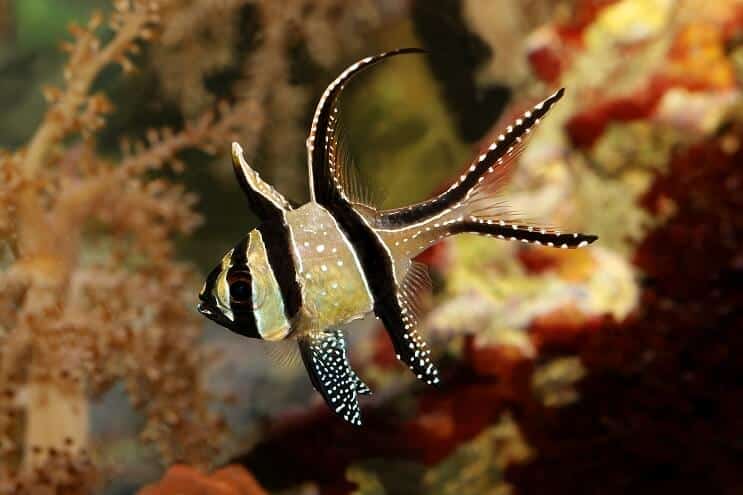
Banggai Cardinalfish are native to the Banggai Islands in Indonesia. These elegant, graceful fish are usually found resting between seagrass beds, coral ledges, and sea anemones during the day as they are nocturnal.
At night, they will feed in groups of up to 200, on plankton and other small crustaceans.
They are very sociable and need to be kept in groups of at least eight to ensure they are happy.
As long as these fish are given enough space, with plenty of hiding spots and barriers, they will be a delight to watch swim around.
If they are kept in a small tank, they will chase each other because they don’t have enough space.
10. Moorish Idol
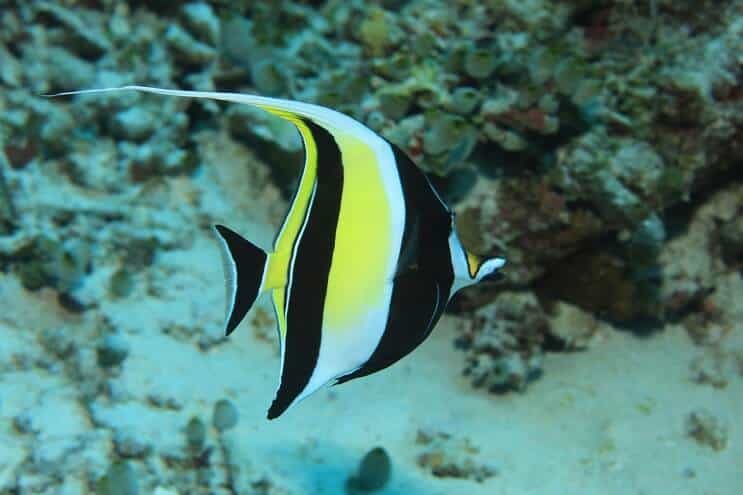
The Moorish Idol is the pin-up poster fish of coral reefs.
They are found in almost every underwater photographer’s portfolio, diving pamphlet and pet store painting.
This beautiful fish is native to the coral reefs of the Indo-Pacific Ocean, they have large thick vertical stripes in contrasting black and white. They also have a sunlight yellow patch towards the back of their body.
They have long snouts with a vibrant yellowy/orange mask running across. Moorish Idols have a long extravagant filament which trails out from the tip of the dorsal fin.
Interestingly they closely resemble Butterflyfish, but they are not in the same family despite sharing similar feeding habits.
They grow to 9 inches and are extremely difficult to keep in captivity due to the diet and tank size they require.
9. Flame Angelfish
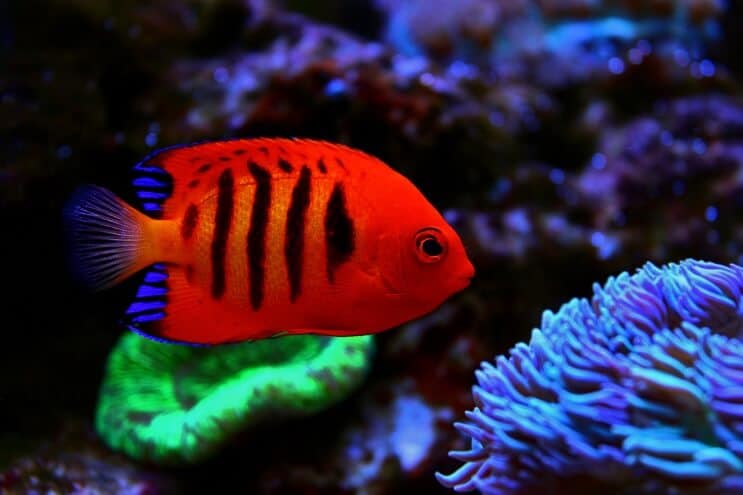
This dwarf Angelfish is very popular amongst both beginner and advanced aquarists. It has a deep red/orange body with black vertical stripes and blue tipped dorsal and anal fins.
Depending on where each fish is found, the colors are slightly different. In Hawaii, they tend to be larger and have a deeper vibrant red color, whereas those found in the Indo-Pacific region tend to be a more orangey-red.
They don’t require a huge tank, in fact 30 gallons will be fine for them.
Flame Angelfish like to live in small groups of around three to seven. Males are likely to fight, so either keep them as a mated pair, or if you’re keeping a group – just have one male.
All these fish are born female and as they mature, the larger more dominant fish will become male.
8. Clownfish
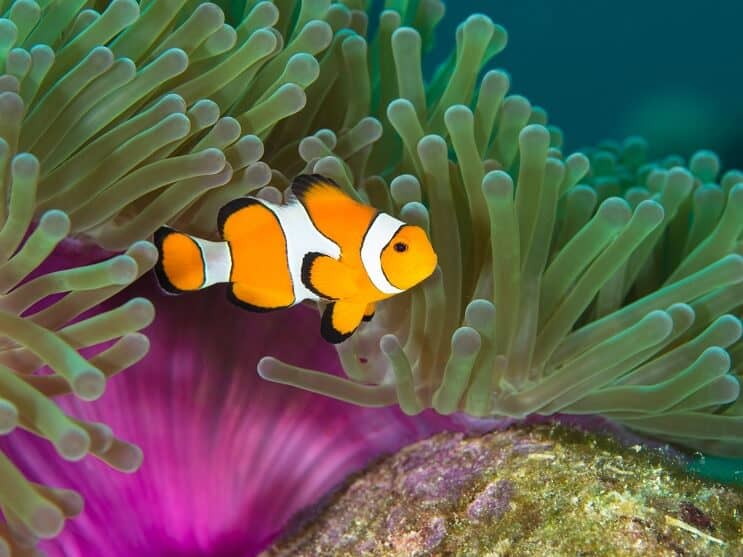
No list would be complete without this cute fish. The Clownfish shot to fame after its appearance in Finding Nemo, and is known by many people now as ‘Nemo’.
This popular aquarium fish, the Ocellaris Clownfish, is also known as a False Clownfish or a Clown Anemonefish, due to them making their homes in sea anemones.
They live in the coral reefs on the coasts of Australia and Southeast Asia.
Clownfish have developed immunity to the toxin by touching the tentacles carefully with different parts of their body. The pair form a symbiotic relationship; the anemone provides shelter and protection, and the clownfish removes parasites and brings food to the anemone.
All Clownfish are hermaphrodites, and are born males with the ability to turn themselves females. Once the change has been made however, they can’t turn back to a male.
This usually happens when two males become mates; the larger and more dominant fish will become the female.
7. Picasso Triggerfish
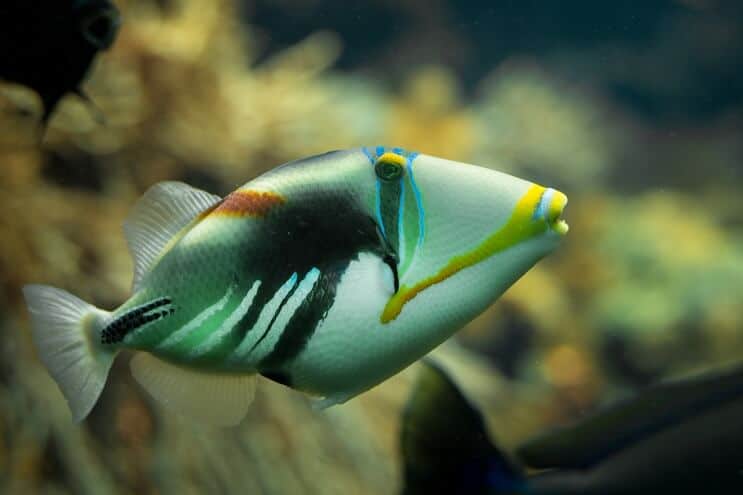
Another beautiful fish is the Picasso Triggerfish; also known as the Humuhumu Triggerfish. Just like the artist it is named after, it has a wacky vibrant painted appearance.
With its tan colored body and blue/black stripes it looks almost cartoon like.
They are native to the Indo-Pacific Ocean, and in the aquarium they are an outgoing species that can learn to recognize their owner.
Triggerfish can however, also be aggressive and should be kept in a tank with other large fish of a similar size (around 10 inches). They also shouldn’t be kept with other Triggerfish.
6. Lionfish
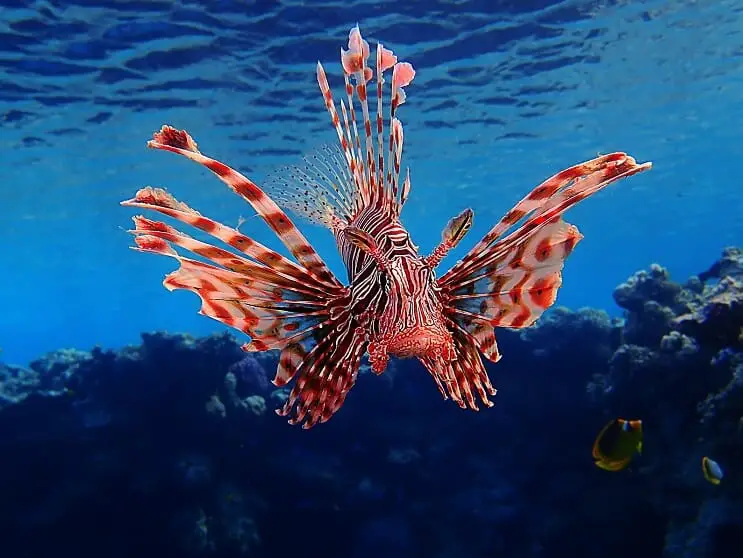
Lionfish are native to the Pacific Ocean and are also known as Dragon Fish, Tiger Fish and Scorpion Fish.
They are actually considered invasive in North America because they don’t have any natural predators and eliminate native species. They reproduce quickly (they release up to 30,000 eggs every 7 days!) and can easily adapt to new environments.
Lionfish are usually anywhere from 2 to 16 inches long and they have the most beautifully striped bodies, arranged in a zebra like pattern.
Their feathery like fins are attractive to smaller fish, and lure them in. Although they might look harmless, they actually have venomous spikes which they use for self-defense.
They have been known to sting humans, and whilst the side effects aren’t nice (vomiting, dizziness and nausea), the venom is not fatal.
5. French Angelfish
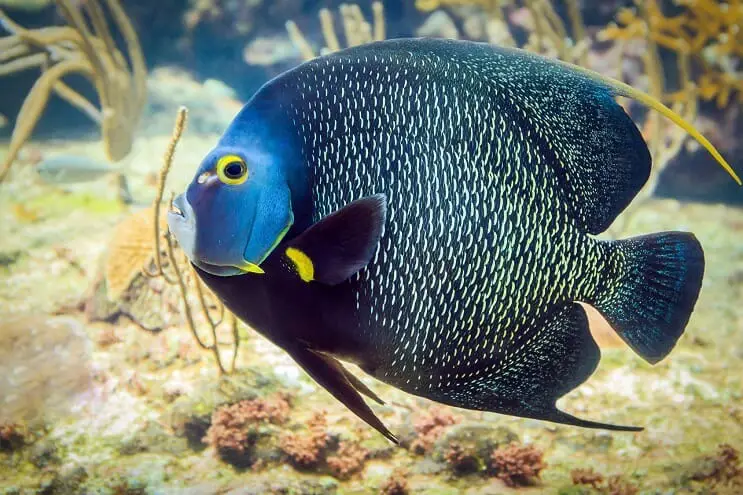
This beautiful fish is native to the shallow reefs of the Bahamas, Florida and the Caribbean. It looks quite different as a juvenile, and has vertical stripes running down its body.
As it matures, the stripes disappear and leave a deep grey/black colored body with flakes of yellow.
In the wild, they are often seen in pairs. However in the aquarium, only one angelfish should be kept per tank. They need a large tank to allow them plenty of swimming space. They can also become territorial so will need plenty of hiding places using rockwork.
The French Angelfish should always be the last addition to a tank so it hasn’t already claimed a territory.
4. Regal Tang
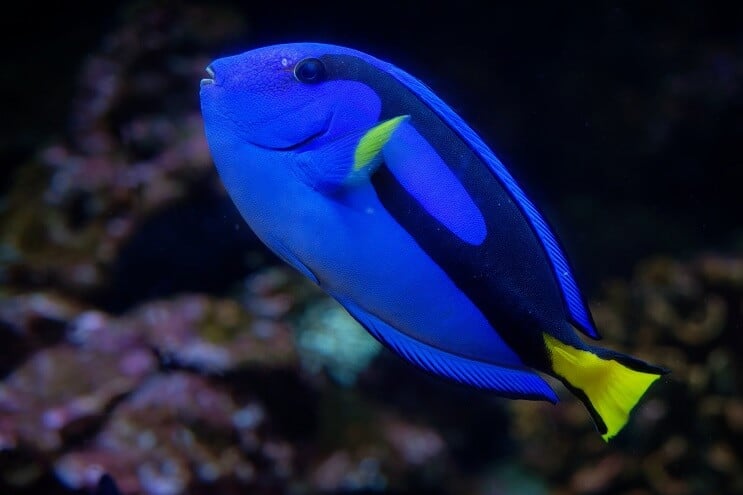
The Regal Tang was another fish which was propelled into popularity from the film ‘Finding Nemo’.
In the film, Dory is a cartoon version of the Regal Blue Tang; also known as the Palette Surgeonfish, Common Surgeon, Pacific Blue Tang and Hippo Tang.
They have oval shaped bodies which are bright blue in color with a yellow tail and pectoral fin. Adults also have a dark blue line which runs across their dorsal fin and curves at the back of the tail.
Their colors changes as they mature. As juveniles they are bright yellow with blue spots near their eyes, and light blue fin tips. As adults their bodies become bluer.
3. Clown Triggerfish
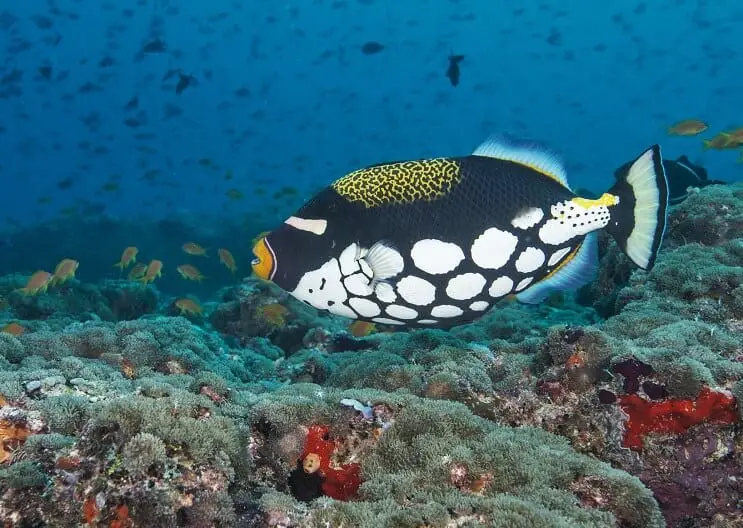
The striking clown triggerfish is instantly recognizable. The lower half of their body is dark with large white spots. The upper half is yellow with small black dots. They have a yellow or white stripe across their face with a yellow snout.
As juveniles they are often reclusive but as they mature their personality comes to life and they become a bit more territorial.
They can be kept with other larger fish, and if you are keeping them with other semi-aggressive species, the trigger should be added last.
Triggerfish need a large tank (at least 120 gallons), to allow them space to swim, and hide if they need to.
2. Juvenile Emperor Angelfish
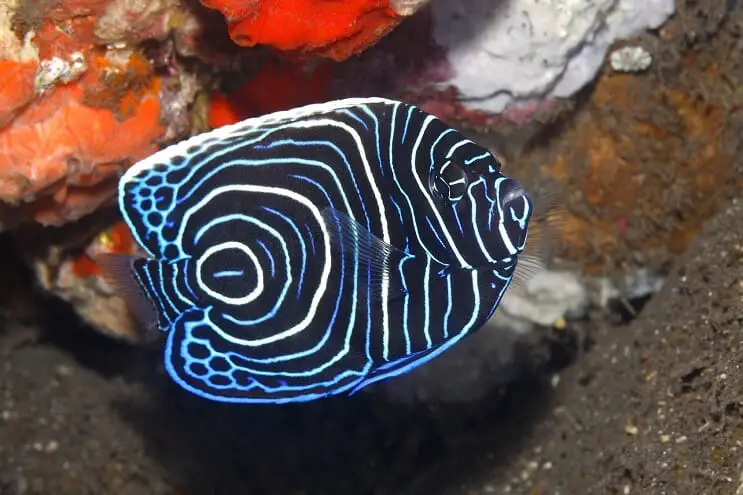
Emperor Angelfish are some of the most beautiful fish in the world. As a juvenile it looks very different to the appearance they will have as an adult.
With a black body and light blue/white vertical lines on their face, they have three white curved bands on their body, with thinner light blue curves in between.
As they develop into adults, their coloring and patterning will completely change, so much so that they were thought to be three different species up until 1933.
Adults have yellow and blue stripes which stretch horizontally across their body.
These stunning fish reach lengths of up to 15 inches, however in captivity they usually grow to around 12 inches.
1. Mandarinfish
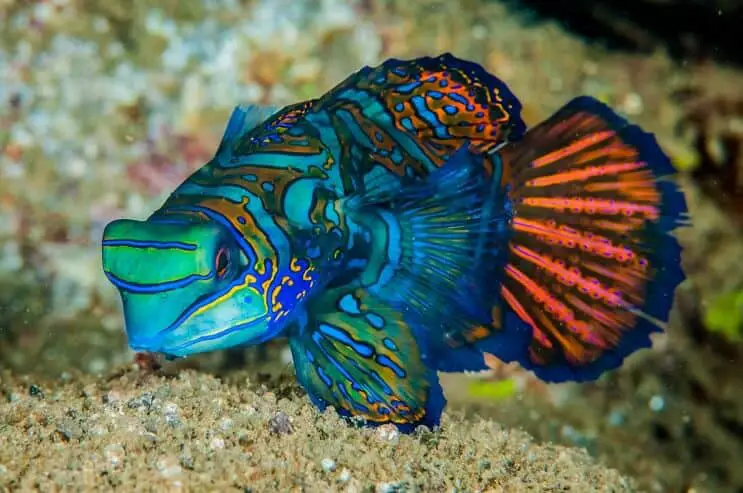
These spectacular looking fish are the most beautiful in the ocean.
It is native to the Pacific Ocean and lives in sheltered lagoons and inshore reefs. It is covered in tiny spikes which inject toxic mucus into anything or anyone who tries to handle them.
The Mandarinfish is one of only two species in the world which can produce its own blue coloring.
Other animals that appear to be blue such as peacocks, don’t actually produce a blue pigment, they have colorless cells which reflect light to make it appear blue.
Summary
So there you have it – a collection of fifteen of the most beautiful fish in the world.
From two fish which were made famous during ‘Finding Nemo’, to the very unique and stunning Lionfish which is able to poison anyone who threatens it.
Each of these fish have striking colors and unique body shapes which makes them the most sought after fish within the aquarium trade.
Do you have a favorite, or even a beautiful fish which hasn’t been listed here? Let us know in the comments section below…

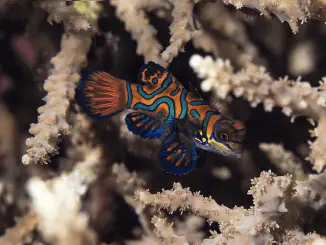

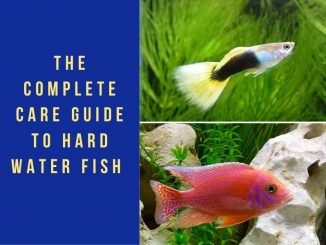
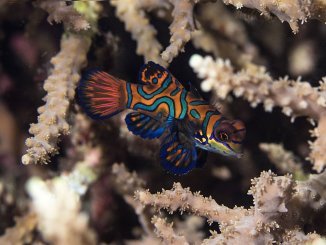
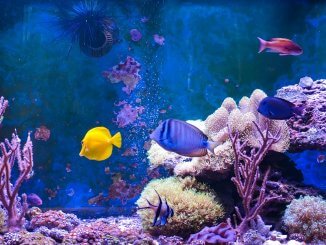
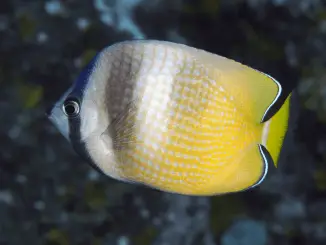
I wish there was a distinction between fresh and saltwater.
nice fish